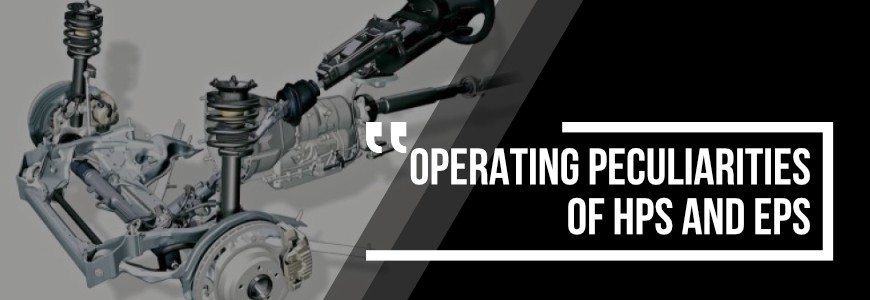
When looking through the list of configuration options of modern cars, it’s common to find there such a mechanism as power steering specified as HPS or EPS.
Operating peculiarities of HPS and EPS
Hydraulic power steering was put into use long before electric power steering. In HPS systems it is a liquid drive that is used for operation, it’s construction requires a hydraulic pump driven by the crankshaft via a belt drive.
When a car is moving straight forward, the fluid exchange goes circle-wise. When the trajectory is changed (by rotation of a steering wheel), the liquid enters the inner cavities of the distributor sleeve. Then it enters the left or right cavity, according to the direction of steering wheel rotation. This is how the piston moves the steering rack components. A steering effort is transmitted to a steering drag rod, thus changing the direction of car movement. Rotation of a steering wheel during parking maneuver – this is when the pump is the most productive. The system is driven by the belt transmission from the crankshaft, but its RPMs when parking are minimal. It becomes clear that the pump does not have enough force to turn the steering wheel. And that’s what manufacturers took into account. Under these conditions, the ECU will signal the additional opening of the valves. More fluid will enter into the steering rack cylinder and, respectively, it will be easier to rotate the steering wheel when parking. But a driver should remember that the pump will operate at full capacity and frequent turning of a steering wheel to a full lock, can reduce its service life.
Though manufacturers started to use EPS systems much later, this mechanism gained a great popularity quite quickly. The main difference between EPS and HPS systems is that there are no belt transmission and hydraulic drive in EPS design. Manipulation is carried out by means of electric motor.
There are two types of EPS layout designs. In the first type, a motor effort is transmitted to the steering rack, while in the second one – to the steering wheel shaft. The first type is the most frequently used one, it’s also called a mechanical type. Asynchronous electric motor is used with this EPS type. A torque is transmitted from the electric motor to the steering rack. EPS is equipped with many sensors, which are linked to the ECU and anti-block system. Data from the sensors is processed, then the signal is sent to the actuator, which is an asynchronous motor.
HPS or EPS? How to make a choice?
Both mechanisms have their advantages and disadvantages.
HPS is not an expensive mechanism, that’s why the cost of the car equipped with HPS will be lower. HPS maintenance isn’t very costly either (provided that the steering rack is faultless). One of the downsides of HPS is the size of the construction itself. HPS system is bulky and needs much space. It may cause problems with VVEL (Variable Valve Event and Lift) repair as it will require dismounting of the wheel pulley from the HPS.
When choosing between the two options – HPS and EPS, consider the way the further maintenance will be carried out. Delayed fluid changeout and belt replacement will unavoidably lead to power steering system repair. Repair will also be required in case of the mechanism overload failure. The unit operation is very much dependent on the engine power, and HPS can reduce the performance. Today HPS systems are mostly used in off-road and commercial vehicles.
EPS has more advantages than disadvantages. The unit doesn’t reduce the engine power. The system doesn’t require regular maintenance as fluids and pumps are not provided in the design. A rolling bearing may be out of service, but it will take it a long enough time to break down. Steering response is faster and sensors transmit signals instantly. EPS occupies little space under the hood making it easier to repair other components. There is no overload on the pump when the steering wheel is turned to a full lock and held in this position for a long time.
Let’s sum up the results. If your vehicle is a passenger car or a crossover, EPS is a better option. As for heavy cars, HPS would be a relevant choice then.



COMMENTS